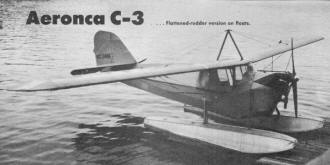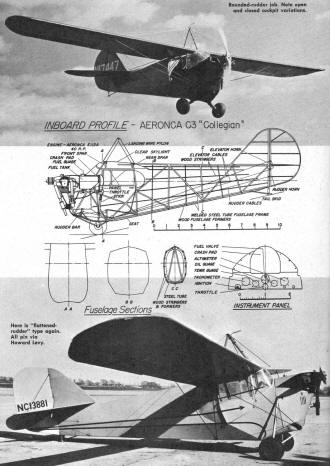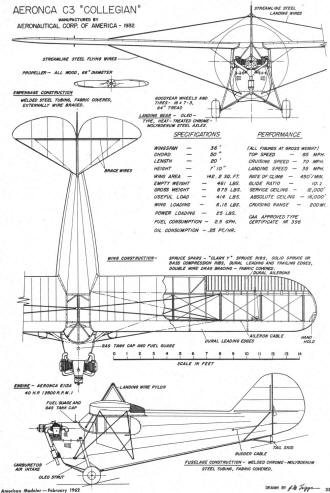|
 This short article and 3-view drawing by James
Trigg appeared in the February 1962 edition of American Modeler magazine.
With a 36-foot wingspan and a mere 40 horsepower for an engine, the Aeronca
C-3 performed more like a powered glider than a typical power plane. Its wing loading
of 6.15 lb/sq.ft. yielded it a climb rate of 450 ft/min and a glide
ratio of 10:1. Only 400 were built before new
FAA airworthiness
standards caused production to halt. One of the first built-up glow engine models
I built as a kid back in Mayo, Maryland, was a
Sterling Aeronca C-3. It was powered
by a Cox Pee Wee .020 engine. I do not remember whether it ever actually flew under
power or not. This short article and 3-view drawing by James
Trigg appeared in the February 1962 edition of American Modeler magazine.
With a 36-foot wingspan and a mere 40 horsepower for an engine, the Aeronca
C-3 performed more like a powered glider than a typical power plane. Its wing loading
of 6.15 lb/sq.ft. yielded it a climb rate of 450 ft/min and a glide
ratio of 10:1. Only 400 were built before new
FAA airworthiness
standards caused production to halt. One of the first built-up glow engine models
I built as a kid back in Mayo, Maryland, was a
Sterling Aeronca C-3. It was powered
by a Cox Pee Wee .020 engine. I do not remember whether it ever actually flew under
power or not.
Aeronca C-3
 by James Trigg by James Trigg
Flattened-rudder version of Aeronca C-3 on floats. Is it real or is it a model?
Founded and incorporated in 1928, the Aeronautical Corporation of America at
Lunken Airport, Cincinnati, Ohio, was one of the first American makers of an inexpensive
"light" airplane of dependable performance and construction.
Under the trade name "Aeronca" the company began at the height of the depression
in 1929 to manufacture the C-2 series monoplane based on a 1925 design by Jean A.
Roche, then senior aeronautical engineer of the U. S. Army Air Corps. The fact that
in those depression days, sales of the C-2 airplanes boomed is a tribute to sound
design and excellence of performance.
A refined version, the C-3 was developed and produced after 1930 by Aeronca and
this continued until 1937, when Aeronca switched its facilities to the Model "K"
which evolved into the famous "Chief" series.
Powered with the Aeronca E113 40-hp two cylinder engine, the little C-3 was truly
one of the first practical, mass produced light planes on the market. Construction
was simple: a welded steel tube fuselage with wooden formers and stringers with
all-wood wings having external streamline steel flying and landing wires. The early
C-3s had open cockpits; later models were enclosed as shown in the drawings.
C-3 performance was spectacular for a light plane of its day and many records
were set with Aeroncas during the early 30s. Somewhat rare today, the C-3 still
turns up at Air Shows and Antique Fly-Ins and always attracts a lot of attention.

Aeronca C-3 "Collegian" Fuselage Frame
Detail

Aeronca C-3 3-View Drawing
Notice:
The AMA Plans Service offers a
full-size version of many of the plans show here at a very reasonable cost. They
will scale the plans any size for you. It is always best to buy printed plans because
my scanner versions often have distortions that can cause parts to fit poorly. Purchasing
plans also help to support the operation of the
Academy of Model Aeronautics - the #1
advocate for model aviation throughout the world. If the AMA no longer has this
plan on file, I will be glad to send you my higher resolution version.
Try my Scale Calculator for
Model Airplane Plans.
Posted July 8, 2024
(updated from original post on 6/2/2013)
|